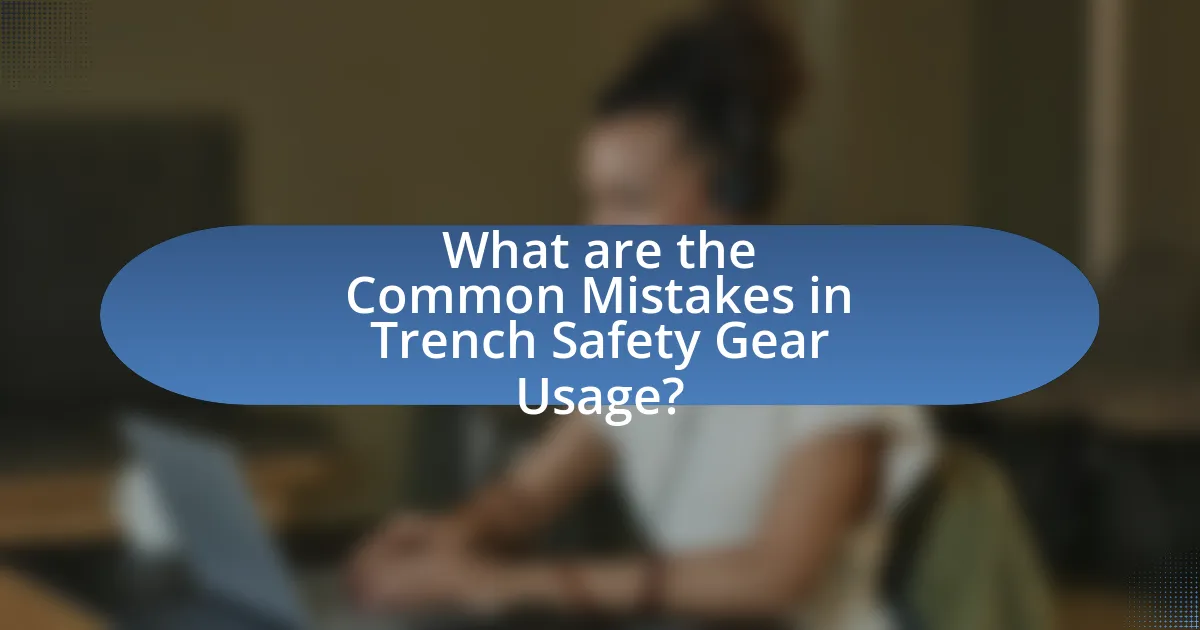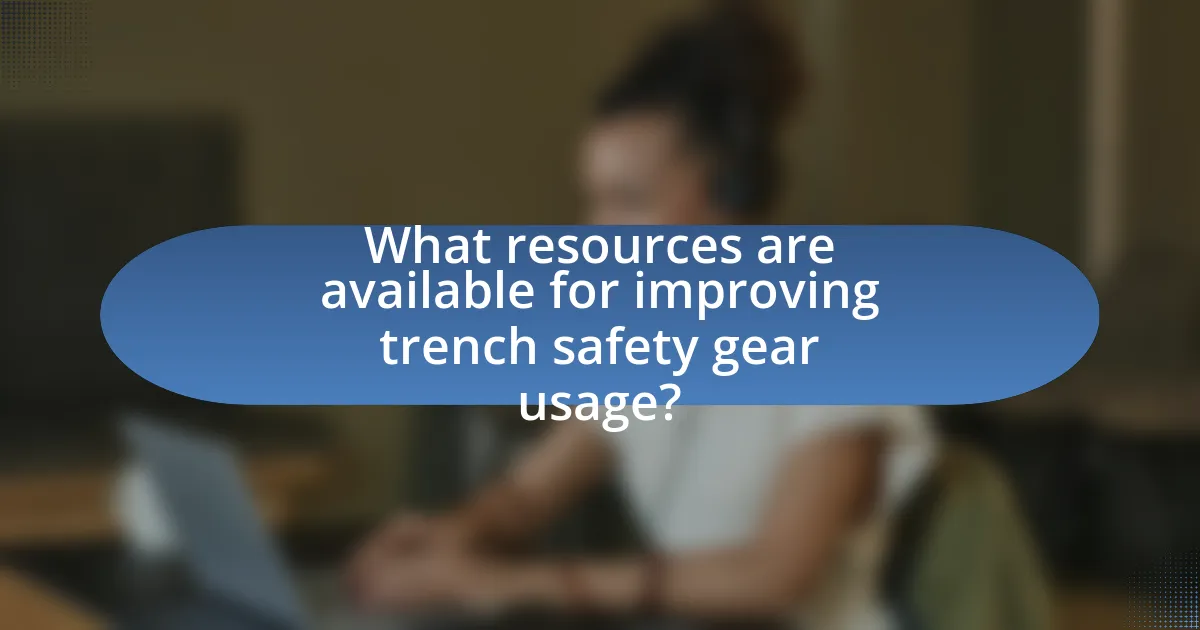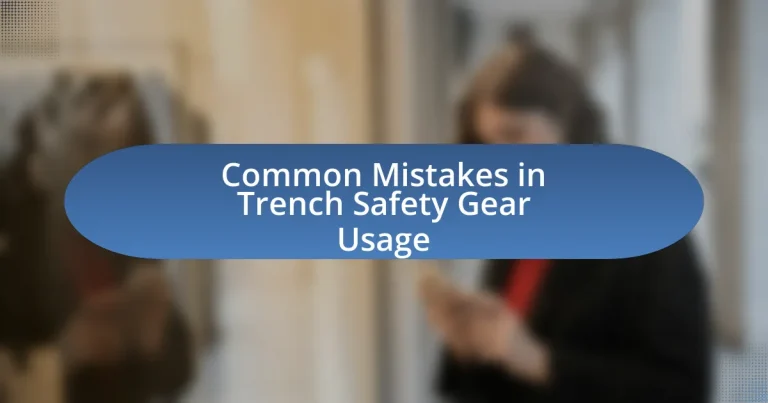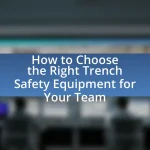The article focuses on common mistakes in trench safety gear usage, highlighting critical errors such as failing to wear appropriate personal protective equipment (PPE), neglecting gear inspections, and improper storage practices. It emphasizes the importance of proper gear usage to prevent accidents and fatalities in trenching operations, where trench collapses pose significant risks. The article also outlines essential components of trench safety gear, the consequences of improper usage, and the necessity of training and awareness to enhance worker safety. Additionally, it provides practical tips for maintaining safety gear and resources available for improving trench safety practices.

What are the Common Mistakes in Trench Safety Gear Usage?
Common mistakes in trench safety gear usage include failing to wear appropriate personal protective equipment (PPE), such as hard hats, gloves, and steel-toed boots, which can lead to serious injuries. Additionally, workers often neglect to inspect their gear before use, resulting in reliance on damaged or ineffective equipment. Another frequent error is not using fall protection systems when working near the edge of a trench, increasing the risk of falls. Furthermore, improper storage of safety gear can lead to contamination or damage, compromising its effectiveness. According to the Occupational Safety and Health Administration (OSHA), proper training and adherence to safety protocols are essential to mitigate these risks and ensure worker safety in trenching operations.
Why is proper usage of trench safety gear crucial?
Proper usage of trench safety gear is crucial to prevent accidents and fatalities during excavation work. Trench collapses can occur rapidly, with the potential to bury workers under tons of soil, leading to severe injuries or death. According to the Occupational Safety and Health Administration (OSHA), approximately 1 in 5 fatalities in the construction industry is related to trenching and excavation, highlighting the importance of adhering to safety protocols. Proper gear, such as helmets, harnesses, and protective footwear, significantly reduces the risk of injury by providing essential protection against falling debris and unstable ground conditions.
What are the potential consequences of improper usage?
Improper usage of trench safety gear can lead to severe consequences, including increased risk of accidents and fatalities. For instance, failure to wear appropriate protective equipment can result in injuries from falling objects or cave-ins, which are significant hazards in trench work. According to the Occupational Safety and Health Administration (OSHA), trench collapses can occur within seconds, and the risk of fatality is high, with a one in five chance of death for workers caught in a collapse. Additionally, improper usage may lead to legal repercussions for employers, including fines and penalties for non-compliance with safety regulations. These consequences highlight the critical importance of adhering to proper safety protocols when using trench safety gear.
How does improper usage impact worker safety?
Improper usage of trench safety gear significantly compromises worker safety by increasing the risk of accidents and injuries. When safety equipment is not used correctly, such as failing to wear helmets or harnesses, workers become vulnerable to falling objects, cave-ins, and other hazards associated with trench work. According to the Occupational Safety and Health Administration (OSHA), improper use of protective gear is a leading cause of fatalities in excavation and trenching operations, with statistics indicating that approximately 1 in 5 fatalities in the construction industry are related to trench collapses. This highlights the critical importance of adhering to safety protocols and proper equipment usage to mitigate risks and protect workers on site.
What types of trench safety gear are commonly used?
Commonly used trench safety gear includes trench boxes, shoring systems, helmets, safety vests, and fall protection equipment. Trench boxes provide a protective barrier against soil collapse, while shoring systems support the walls of the trench. Helmets protect workers from falling objects, and safety vests enhance visibility on job sites. Fall protection equipment, such as harnesses and lanyards, is essential for preventing falls into the trench. These items are critical for ensuring worker safety in trenching operations, as outlined by OSHA regulations, which emphasize the importance of proper safety gear to mitigate risks associated with trench work.
What are the essential components of trench safety gear?
The essential components of trench safety gear include protective helmets, trench boxes, shoring systems, safety vests, and proper footwear. Protective helmets safeguard against falling objects, while trench boxes and shoring systems provide structural support to prevent collapses. Safety vests enhance visibility, and proper footwear ensures traction and protection from hazards. According to OSHA regulations, these components are critical for minimizing risks associated with trench work, which can lead to serious injuries or fatalities if not properly utilized.
How do different types of gear serve specific safety needs?
Different types of gear serve specific safety needs by providing protection against various hazards encountered in trench work. For instance, hard hats protect against falling objects, while steel-toed boots safeguard feet from heavy equipment. High-visibility vests enhance worker visibility, reducing the risk of accidents in low-light conditions. Additionally, harnesses and lanyards prevent falls into trenches, which can be particularly deep and dangerous. According to the Occupational Safety and Health Administration (OSHA), proper use of personal protective equipment (PPE) can significantly reduce the risk of injury in hazardous environments, emphasizing the importance of selecting appropriate gear for specific safety needs.
What are the most frequent mistakes made with trench safety gear?
The most frequent mistakes made with trench safety gear include improper selection of equipment, failure to inspect gear before use, and neglecting to train workers on proper usage. Improper selection occurs when workers choose gear that does not meet the specific requirements for the trench conditions, such as depth and soil type, which can lead to equipment failure. Failure to inspect gear can result in using damaged or worn equipment, increasing the risk of accidents. Additionally, neglecting to train workers on the correct use of safety gear can lead to misuse, further compromising safety. According to the Occupational Safety and Health Administration (OSHA), proper training and equipment selection are critical for preventing trench-related accidents, which account for a significant number of workplace fatalities each year.
How does incorrect sizing affect safety gear effectiveness?
Incorrect sizing significantly reduces the effectiveness of safety gear by compromising fit and protection. When safety gear, such as helmets, harnesses, or gloves, does not fit properly, it can lead to inadequate coverage, increased risk of injury, and decreased functionality. For instance, a helmet that is too loose may shift during a fall, failing to protect the wearer’s head, while a harness that is too tight can restrict movement and cause discomfort, leading to improper use. Studies have shown that improperly fitted personal protective equipment (PPE) can increase the likelihood of accidents by up to 30%, highlighting the critical importance of correct sizing in ensuring safety gear performs as intended.
What are the risks of neglecting maintenance on safety gear?
Neglecting maintenance on safety gear significantly increases the risk of equipment failure, which can lead to serious injuries or fatalities. For instance, worn-out harnesses or helmets may not provide adequate protection during a fall or impact, resulting in severe consequences for workers. According to the Occupational Safety and Health Administration (OSHA), improper maintenance of personal protective equipment (PPE) is a leading cause of workplace accidents, highlighting the critical need for regular inspections and upkeep. Regular maintenance ensures that safety gear functions as intended, thereby reducing the likelihood of accidents and enhancing overall workplace safety.
How can awareness of mistakes improve trench safety gear usage?
Awareness of mistakes can significantly improve trench safety gear usage by enabling workers to identify and rectify unsafe practices. When individuals recognize common errors, such as improper fitting of safety gear or neglecting to use protective equipment, they can take proactive measures to ensure compliance with safety standards. For instance, a study by the Occupational Safety and Health Administration (OSHA) indicates that proper training and awareness of past incidents can reduce trench-related accidents by up to 50%. This highlights the importance of learning from mistakes to foster a culture of safety and accountability in trench work environments.
What training is necessary to avoid common mistakes?
To avoid common mistakes in trench safety gear usage, comprehensive training on proper equipment selection, usage protocols, and hazard recognition is necessary. This training should include hands-on demonstrations of how to correctly wear and maintain safety gear, such as helmets, harnesses, and protective footwear, to ensure that workers understand the importance of each item in preventing injuries. Additionally, training should cover the identification of potential hazards associated with trench work, including soil stability and environmental conditions, to enhance situational awareness. According to the Occupational Safety and Health Administration (OSHA), effective training significantly reduces the likelihood of accidents and injuries in trenching operations, emphasizing the need for ongoing education and practical assessments to reinforce safe practices.

How can users ensure proper trench safety gear usage?
Users can ensure proper trench safety gear usage by conducting thorough inspections of all equipment before use. Regular checks for wear and tear, compliance with safety standards, and proper fit are essential to maintain effectiveness. According to the Occupational Safety and Health Administration (OSHA), proper gear includes hard hats, safety glasses, gloves, and high-visibility clothing, which must be worn at all times in trenching operations to mitigate risks. Additionally, training on the correct use of safety gear significantly reduces the likelihood of accidents, as highlighted by studies showing that well-trained workers are 60% less likely to experience injuries related to trench work.
What best practices should be followed when using trench safety gear?
When using trench safety gear, it is essential to ensure proper training and adherence to safety protocols. Workers must be trained in the correct use of trench safety equipment, including shoring systems, protective helmets, and harnesses. Regular inspections of the gear should be conducted to identify any wear or damage, ensuring that all equipment meets safety standards set by organizations such as OSHA, which mandates that protective systems be in place for trenches deeper than five feet. Additionally, maintaining clear communication among team members about safety practices and potential hazards is crucial for preventing accidents.
How can regular inspections enhance safety gear reliability?
Regular inspections enhance safety gear reliability by identifying wear and tear, ensuring that equipment functions correctly. Consistent evaluations allow for the detection of defects or damage that could compromise safety, such as frayed straps or malfunctioning mechanisms. According to the Occupational Safety and Health Administration (OSHA), regular checks can reduce the likelihood of equipment failure, which is crucial in high-risk environments like trenches where safety gear is essential for preventing accidents and injuries.
What role does proper training play in effective gear usage?
Proper training is essential for effective gear usage as it ensures individuals understand how to correctly operate and maintain safety equipment. Training provides knowledge about the specific functions and limitations of gear, which reduces the risk of accidents and enhances overall safety. For instance, a study by the National Institute for Occupational Safety and Health (NIOSH) found that workers who received comprehensive training on trench safety equipment were 50% less likely to experience accidents compared to those who did not receive such training. This highlights the critical role that proper training plays in maximizing the effectiveness of safety gear in preventing injuries and ensuring compliance with safety regulations.
What are the signs of wear and tear in trench safety gear?
Signs of wear and tear in trench safety gear include visible damage such as frayed straps, cracks in hard hats, and worn-out harnesses. These indicators suggest that the gear may no longer provide adequate protection. For instance, frayed straps can compromise the integrity of a harness, while cracks in hard hats can lead to failure during impact. Regular inspections should be conducted to identify these signs, as the Occupational Safety and Health Administration (OSHA) emphasizes the importance of maintaining safety equipment to ensure worker safety in trenching operations.
How can users identify when gear needs replacement?
Users can identify when gear needs replacement by regularly inspecting for visible signs of wear, such as fraying, cracks, or discoloration. These indicators suggest that the gear may no longer provide adequate protection. Additionally, users should refer to manufacturer guidelines, which often specify replacement timelines based on usage frequency and environmental conditions. For instance, safety helmets typically require replacement every five years, while harnesses may need to be replaced after a fall or if they show signs of damage. Regular maintenance checks and adherence to these guidelines ensure that users maintain optimal safety standards.
What maintenance routines should be established for safety gear?
Regular inspection, cleaning, and proper storage are essential maintenance routines for safety gear. Inspections should occur before each use to identify any signs of wear, damage, or contamination, ensuring that the gear meets safety standards. Cleaning should follow manufacturer guidelines to remove dirt, chemicals, and biological contaminants, which can degrade materials over time. Proper storage in a cool, dry place prevents deterioration from environmental factors. According to the Occupational Safety and Health Administration (OSHA), maintaining safety gear is crucial for ensuring worker protection and compliance with safety regulations.

What resources are available for improving trench safety gear usage?
Resources available for improving trench safety gear usage include training programs, safety guidelines, and equipment standards. Organizations such as the Occupational Safety and Health Administration (OSHA) provide comprehensive training resources and safety regulations specifically for trench safety, emphasizing the importance of proper gear usage. Additionally, the National Utility Contractors Association (NUCA) offers educational materials and workshops focused on trench safety practices. These resources are designed to enhance awareness and compliance, ultimately reducing the risk of accidents associated with trench work.
Where can users find training programs for trench safety?
Users can find training programs for trench safety through organizations such as the Occupational Safety and Health Administration (OSHA), which offers resources and training materials on trench safety. Additionally, many local community colleges and vocational schools provide specialized courses in trench safety, often aligned with OSHA standards. Industry associations, such as the National Utility Contractors Association (NUCA), also offer training programs and certifications focused on trench safety practices. These programs are designed to educate workers on safe excavation practices and compliance with safety regulations.
What organizations provide guidelines for trench safety gear usage?
The organizations that provide guidelines for trench safety gear usage include the Occupational Safety and Health Administration (OSHA) and the National Institute for Occupational Safety and Health (NIOSH). OSHA sets forth regulations and standards for trench safety, including the requirement for protective gear such as hard hats, safety boots, and fall protection systems. NIOSH conducts research and provides recommendations to enhance worker safety in trenching operations, emphasizing the importance of proper gear to prevent injuries. These organizations are recognized authorities in occupational safety, ensuring that guidelines are based on extensive research and industry best practices.
How can online resources assist in understanding safety gear best practices?
Online resources can significantly enhance understanding of safety gear best practices by providing access to comprehensive guidelines, instructional videos, and expert articles. These resources often include detailed information on the correct usage, maintenance, and selection of safety gear, which is crucial for preventing common mistakes in trench safety gear usage. For instance, the Occupational Safety and Health Administration (OSHA) offers online training materials that outline the necessary safety equipment for trench work, emphasizing the importance of proper gear to mitigate risks associated with trench collapses. Additionally, platforms like the National Safety Council provide case studies and best practice recommendations that help users learn from past incidents, reinforcing the importance of adhering to safety protocols.
What practical tips can enhance trench safety gear effectiveness?
To enhance trench safety gear effectiveness, ensure that all equipment is properly fitted and regularly inspected for wear and tear. Proper fitting prevents gear from slipping or becoming ineffective during use, while regular inspections help identify any damage that could compromise safety. According to the Occupational Safety and Health Administration (OSHA), using well-maintained and correctly fitted safety gear significantly reduces the risk of accidents in trenching operations. Additionally, training workers on the correct use and limitations of their safety gear further improves its effectiveness, as informed personnel are more likely to utilize the equipment correctly in hazardous situations.


